RB Leipzig’s 3-4-2-1 fails in Bremen
Since returning from the winter break, RB Leipzig have failed to replicate the outstanding performances that had shocked the Bundesliga in the Hinrunde. Looking to remedy their drop-off, Hasenhüttl moved away from the customary 4-2-2-2 against Werder Bremen, in favour of a 3-4-2-1. The change certainly didn’t bring about the desired result, but was an interesting one in itself and will be the basis of this analysis.
Although many teams are enjoying success with a 3-4-2-1 shape this year, it was particularly surprising to see this come from Leipzig. It could potentially be to create greater security against more direct attacks, as the midfield ‘2-2’ is retained while the backline is bolstered over an additional striker. Furthermore, similar structures can sometimes form naturally from Leipzig’s possession game – against Hoffenheim they created a back-three by the use of asymmetrical full-backs while it’s not uncommon to see a six drop to the side of the centerbacks during build-up.
Impact on the Pressing Game
Leipzig’s pressing shape acted quite similarly to that of a typical 3-4-2-1. The front three’s role was largely to funnel the Werder build-up towards the wider areas, which began with curved pressing runs from Werner to direct the central centerback towards a particular side. They commonly drew the opponents to play down the right of Leipzig’s shape, for reasons which I’m not particularly sure. In these moments, Werder would try to challenge the defense with direct lofted passes down the left flank, where Junuzovic would commonly make overloading diagonal runs while Pizarro and Bauer stretched the link between Upamecano and Schmitz. This was a common movement pattern from the home team, which threatened to disrupt the stability of Leipzig though it failed to conjure up any concrete attacking opportunities.
The additional centerback in the defensive line gave added protection against the more direct attacks of Werder. Both Upamecano and Compper were particularly man-oriented and against the two opposition strikers, and the former in particular was strong in covering Pizarro who commonly dropped to receive vertical passes.
A noticeable change from their typical performances was the lesser intensity of movements inside the defensive block. For example, if Werner was bypassed centrally, there was often little reaction from Sabitzer or Forsberg in recreating access and preventing or at least slowing the progression. This is less likely to be a product of the formation change, although their lesser presence in the first line could have resulted in a more passive approach from the forwards, which I doubt was intended from the management.
Impact on Vertical Game
Obviously, the change in shape didn’t result in a deviation from their vertical game which is deep-rooted in Leipzig’s successes so far. The altered structure, however, did have an important influence on the tactics behind this direct strategy. By removing a forward from their attack, Leipzig’s change was theoretically counterproductive. In an attacking style where high presence in the last line is crucial, their new attacking shape made it more difficult to occupy these spaces as dominantly. The weaker occupancy of attacking areas made it more difficult to use their direct and vertical combinations and overload the opponents’ defensive line. Moreover, their ability to create counterpressing overloads for a miscued direct pass were similarly diminished.
Still, the side aimed to play vertically into the front three, usually with Werner being the recipient of a direct pass and being able to play back towards his own goal. However, this structure resulted in a more stretched attacking group which gave less connectivity to create combinations. A key feature of how Leipzig combine is their directness towards goal. They often play one vertical pass followed by a shorter backwards pass and so forth, which allows for fast progression due to the superior perspective of the recipient of the shorter pass. What this requires, however, is sufficient vertical staggering, with players positioned on different ‘heights’ moving up the field. Without this, it’s much more difficult to play the consecutive vertical back-and-forth passes to break the lines.
And this is exactly what Leipzig lacked in their offensive 3-2-4-1. The front three were typically stretched, with little vertical staggering conducive to how they play. Combinations struggled to move past the second or third pass at the most, and it was particularly difficult to combine directly towards the Bremen goal. In fact, some of their most promising combinations of the first half came after a turnover when, due to the pressing shape, Leipzig were in a more staggered structure (and crucially with the front three better connected). They interplayed the ball diagonally well, often from right to left, with the greater space afforded by Bremen an obvious factor in these moments, too.
Leipzig’s issue was most noticeable during build-up through Upamecano, who sometimes had to carry the ball up-field towards a dead-end due to a lack of options ahead of him. Sabitzer would either be positioned in the right half-space, with a poor receiving angle to do anything but a wall pass to a nearby player, or much closer to the touchline where he was completely inaccessible. A positive impact of these movements, would be the space in the channel that would open up for Werner to use his outstanding movement and speed, but it mainly resulted in few progressive options to play into.
A Possible Solution
Leipzig could’ve benefitted in these moments from better spacing from the front three. Ideally, the three could be better connected to enable more support for a receiver on a vertical pass, and more ball-oriented to increase the ability to overload Werder’s defensive line. An interesting adaption could’ve been a slight ball-oriented rotation of the triangle in order to afford Upamecano (or likewise Compper on the left) with more and better passing options.
The basis of this idea, is that Upamecano would typically have two of the three forwards available to some extent for passes, with the third making runs into depth. Along with Schmitz and Demme, this would provide the centerback with at least four progressive options, increasing the probability that at least one would be available and making total coverage more difficult. Furthermore, the adaption could increase more diagonal connections between players, which would mean more triangles and better combinations. The greater ball-orientation allows for overloads to come more easily, and would enhance Leipzig’s counterpressing threat upon semi-planned turnovers.
Additionally, one would expect this greater ball-orientation to force Werder into a more-shifted shape which could result in potential to attack through a switch. If Pizarro, for example, covered the inside option to Demme then they would have less access to prevent or slow-down a switch of play. However, it’s possible that the five-man defensive line could offer a sufficient level of protection for the hosts in reaction to these moments. The initial ball-orientation of the structure may also make their attack slightly isolated, and have less protection in transition, too.
Of course, this is only a hypothetical idea and it’s impossible to carry out a strategy on the pitch exactly how you envisage. The main principle behind this adaption would simply be a greater ball-orientation of the attacking three to help Leipzig maintain their direct game despite the lack of a second striker.
Front Three Asymmetry
Some of Leipzig’s most promising moments came from the natural asymmetry that sometimes developed between the front three. Interestingly, it was usually Sabitzer who played in deeper positions but in four or five instances through the first half, Forsberg was able to receive the ball in the left half-space and face the goal. Sometimes this required an outwards dribble to break away from his man, which the Swede is obviously capable of. During these moments, though, Sabitzer would typically occupy a higher position on the defensive line and be alongside Werner, forming a pairing with dangerous movements into space behind the defense.
In these moments, Forsberg sometimes benefited from the opponents’ reduced access which was in part a product of the dangerous runs from Werner and Sabitzer. This allowed him to receive the ball and create more time for himself, turning to face the goal from the half-space which gave him a beneficial field of view for teammates’ movements. It became a threatening feature of the away side’s attack from the second minute, where he dribbled around his man before playing through Halstenberg for a cut-back.
Revert to a 4-2-2-2
By introducing Selke for Compper in the 56th minute, Leipzig reverted to their more familiar 4-2-2-2. Yet minutes later, they failed to defend a simple free-kick routine from Werder and found themselves down by two. Grillitsch timed his run excellently with the kick and was able to (very easily) get separation from Schmitz whose sight of the kick was blocked by the main group of players.
At this point, it became difficult for Leipzig to make a return into the game. Their hosts were more content to defend in a deeper block and prevent Leipzig from using the vertical combinations into depth. With a low-sitting and compact defense, it becomes easier to block the direct ground passes which forms the basis of RBL’s attack, and is something which a number of teams have started doing after going ahead against the league newcomers. From this deep position, Bremen could quickly transition into dangerous counter-attacks against an open structure. This brought about the final goal, where the hosts easily found space behind Ilsanker before switching the ball back into the middle.
Bremen
Obviously, the most interesting part of the tie was Leipzig’s experiment with the 3-4-2-1, but credit needs to be given to Bremen who defended well throughout. The intensity of their defensive line and deep midfielders was impressive, and crucial in preventing Leipzig from forming any combinative attacks. The pressure on the first receiver was consistently effective and prevented them from cleanly making a wall-pass or flick-on to a teammate, which emphasised the isolated nature of the trio in their new structure.
In some cases, the man-oriented nature of the defensive line was questionable, especially when their midfield lacked great access to a player such as Forsberg. In these moments, the speed and guile of the movement from Werner and Sabitzer could have caught their opponents out. Simply through the speed of their movements, they were capable of breaking away from their marker though the weighting of the crucial pass let them off of the hook at times.
Their deeper defending in the second half prevented Leipzig from creating any good-quality chances at all, even when Hasenhüttl’s side changed back to their 4-2-2-2. The compactness of their deeper block reduced the effectiveness of Leipzig’s verticality, while creating greater room to threaten in offensive transition.
Conclusion
If going by the result alone, we won’t be seeing another 3-4-2-1 from Leipzig any time soon. But as the map above implies, they can be considered quite hard-done by. The opener came from a wonder goal by Junozovic, and the second from a set piece. We can count the third almost irrelevant due to the game state and when taking all of these things into consideration, the match wasn’t as worrying as the final result suggests. In addition, one issue with expected goals is that it doesn’t account for the situations where a shooting-opportunity is missed despite a threatening situation being created. These instances were scattered throughout the Leipzig performance with final passes not being weighted correctly or cut-backs not finding their man.
With that being said, a team of Leipzig’s quality who were one of the best teams in Europe during the first half of the season, will still be disappointed with the performance. Their execution of the 3-4-2-1 wasn’t conducive to their vertical attacking style which thus posed little threat on an impressive Werder defence. Upon the soon return of Naby Keïta and Yussuf Poulsen, I’m sure we’ll see a return to the favoured 4-2-2-2 shape


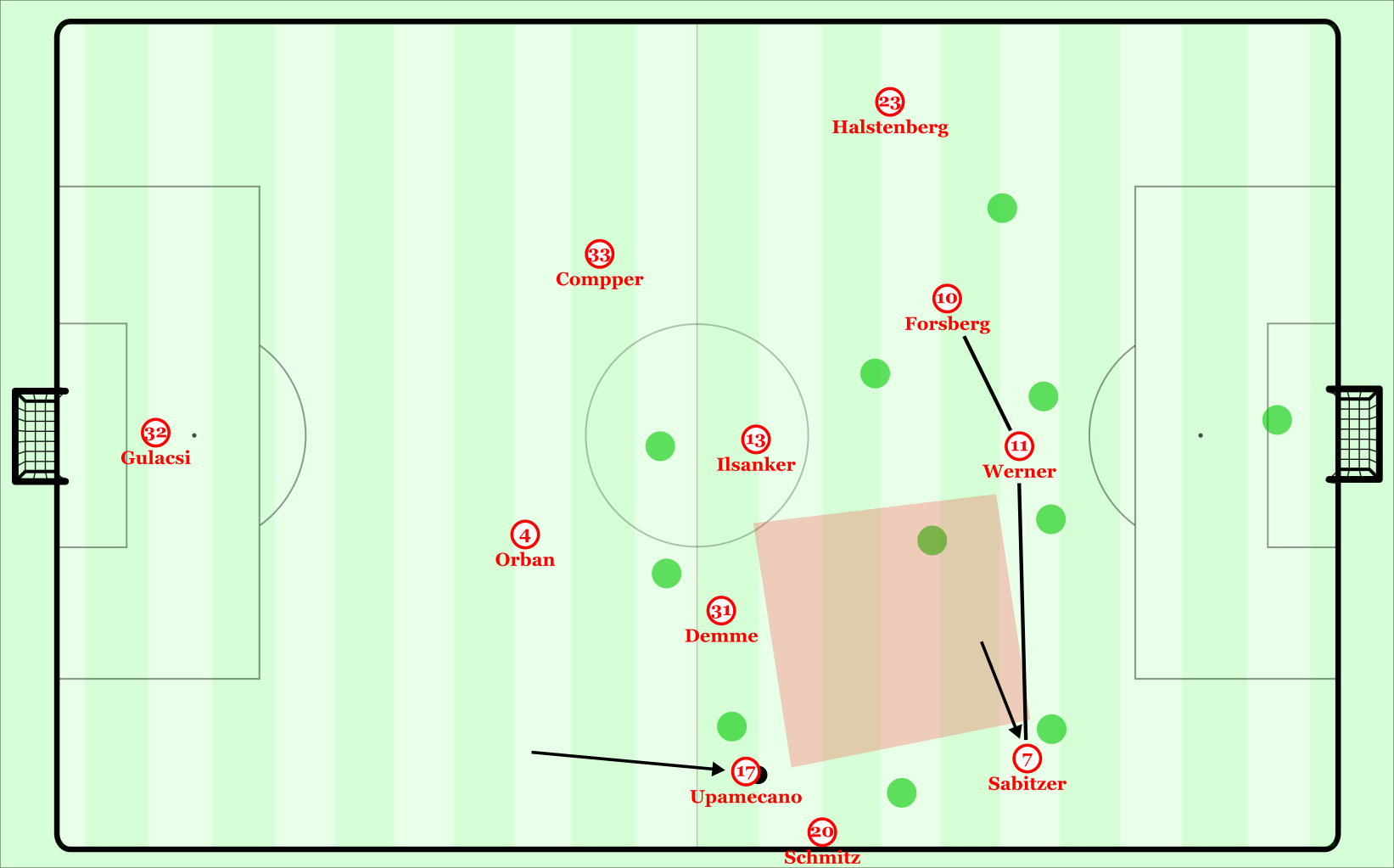
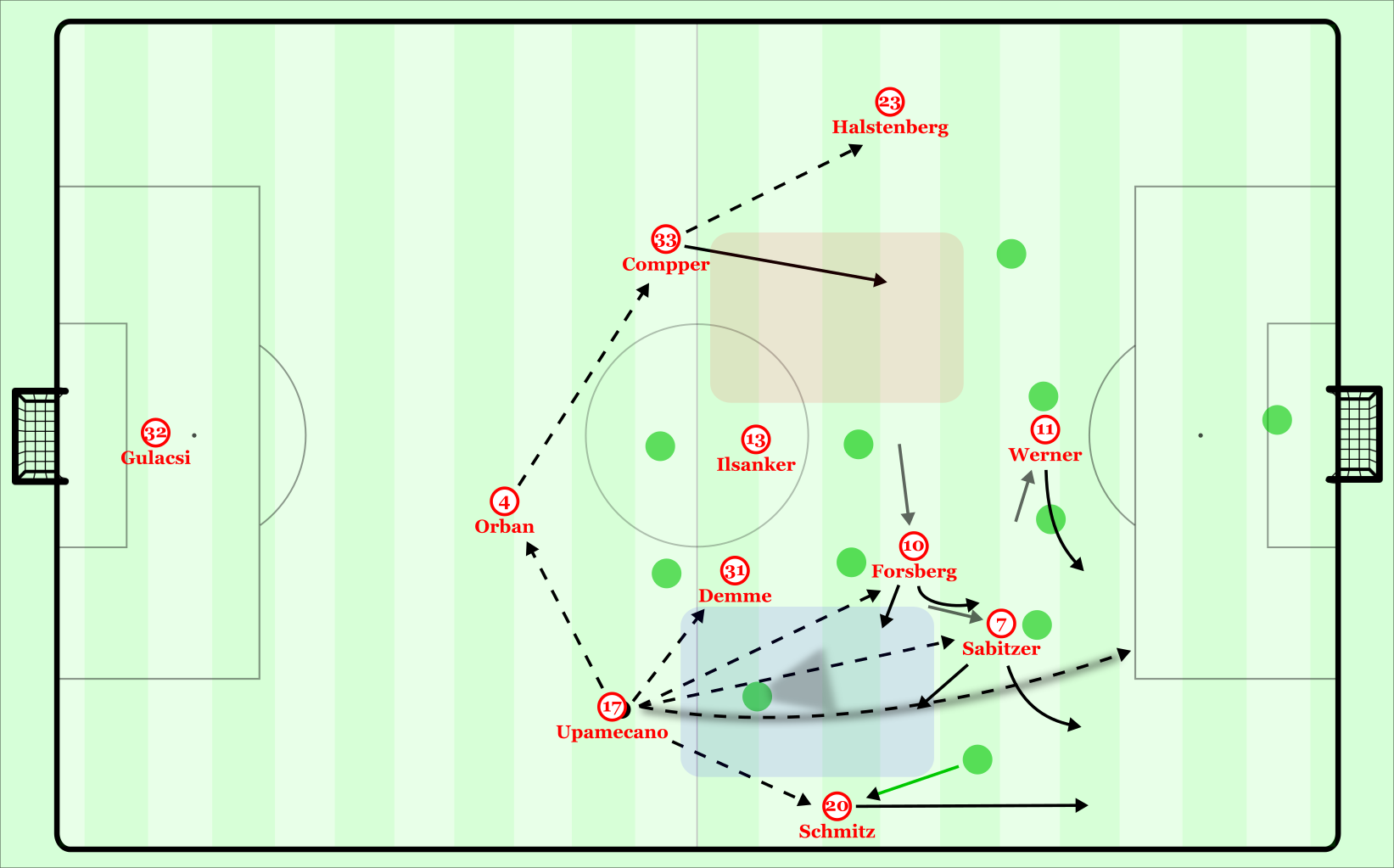
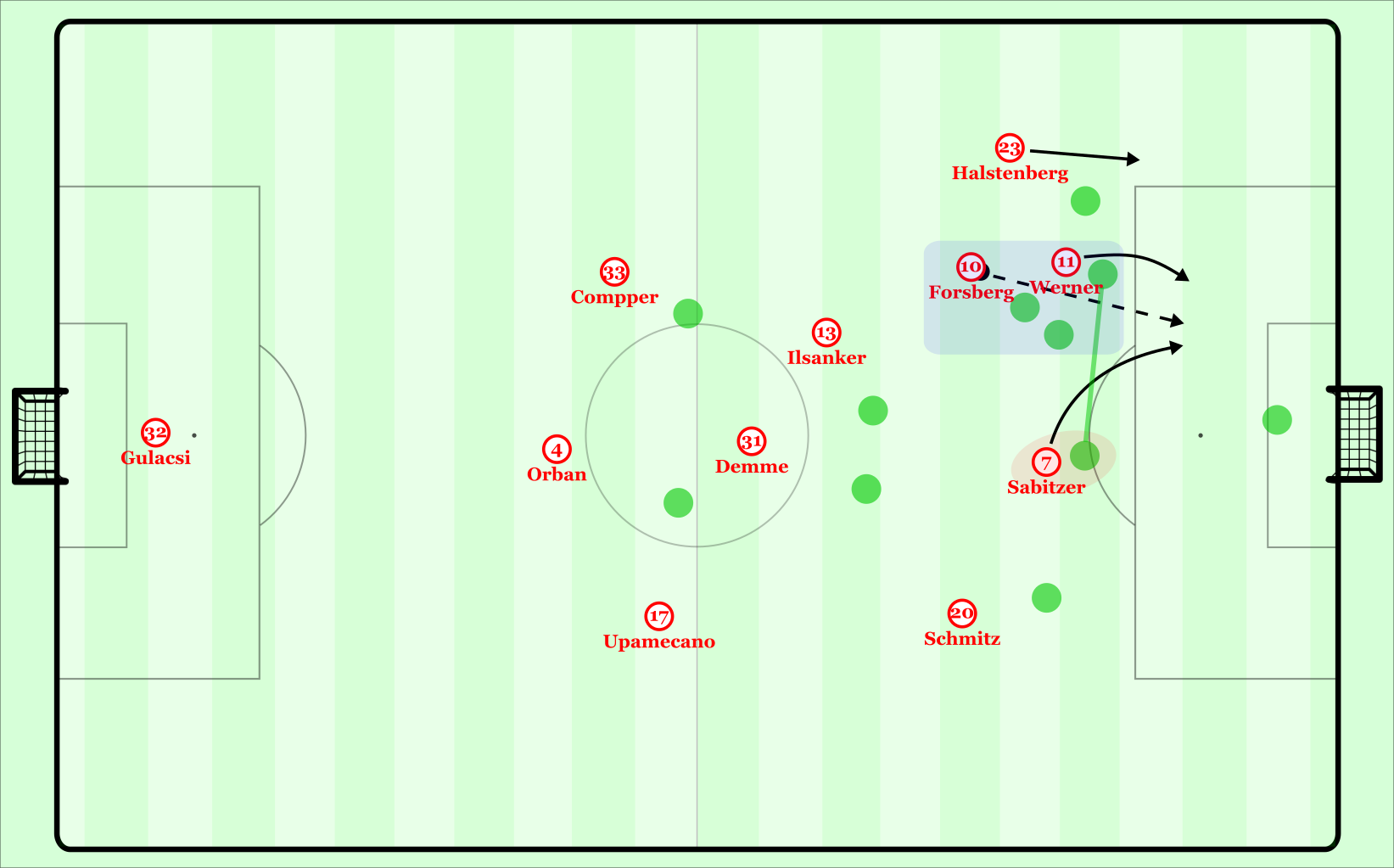
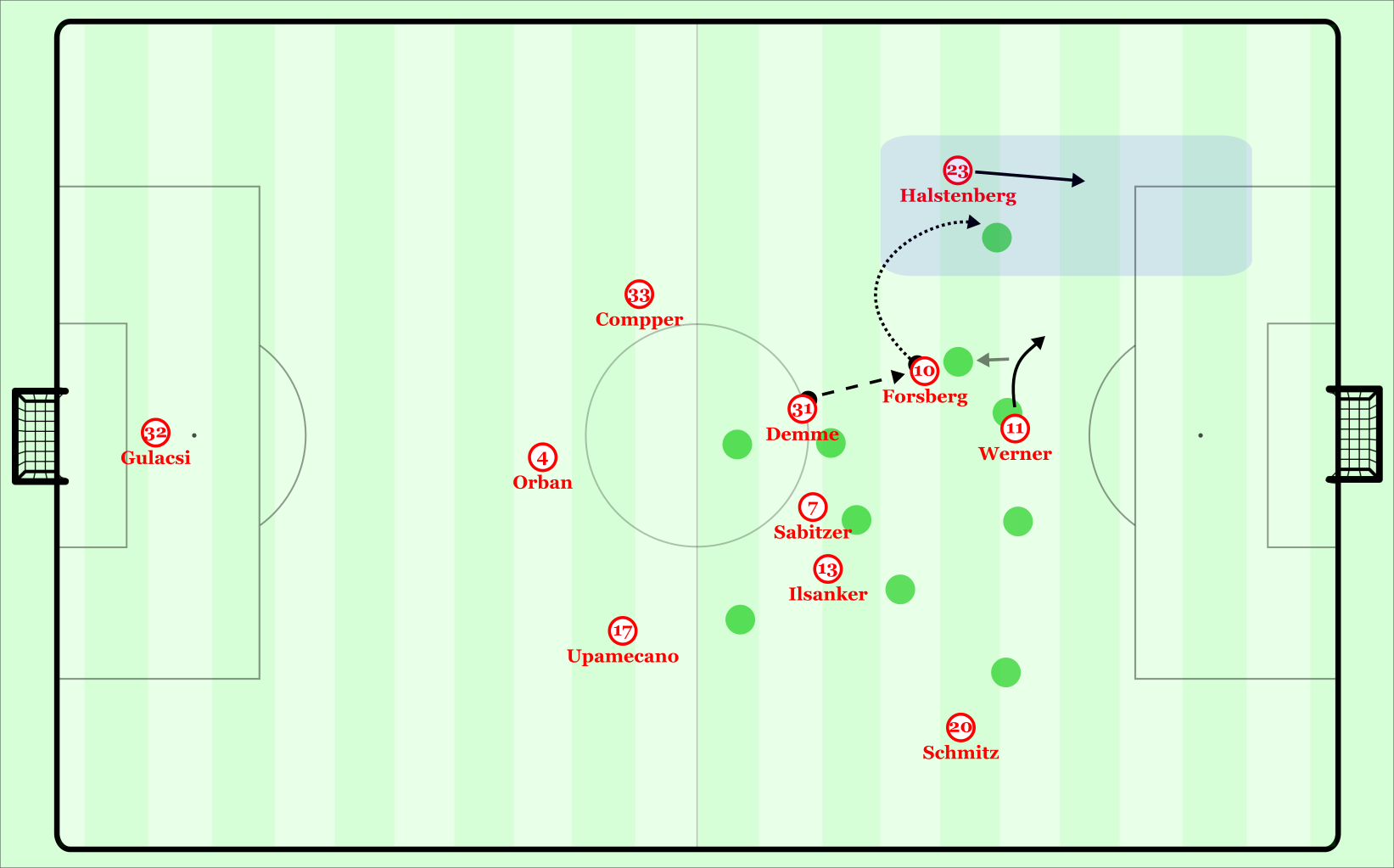
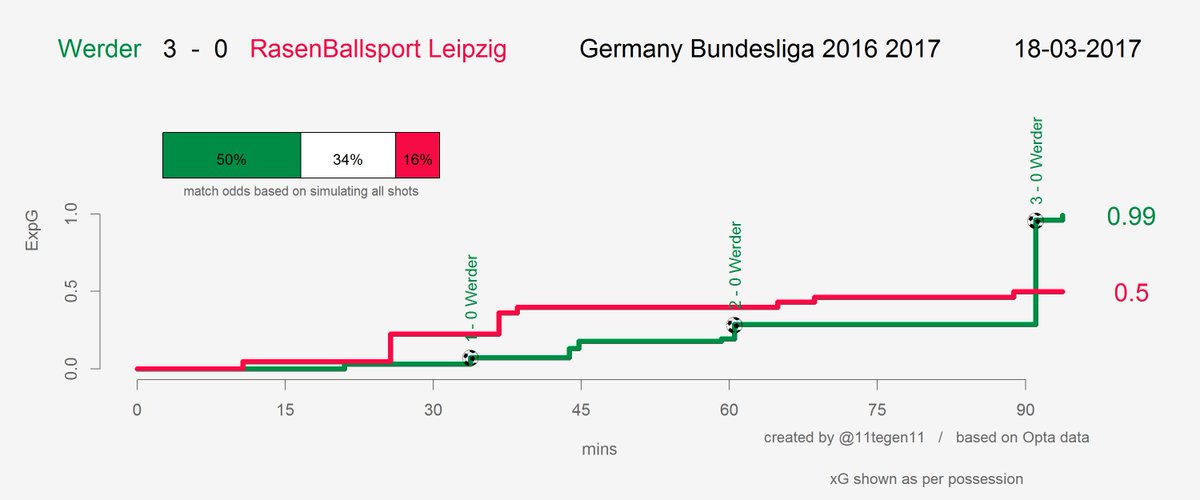
1 Kommentar Alle anzeigen
Jon March 21, 2017 um 9:51 pm
Love the article as always. If I could offer a piece suggestion–maybe either a team-analysis or match-analysis of Monaco? They seem to be on the tip of every pundit’s tongue, whether regarding results of EPL transfer gibberish. Sincere best, Jon